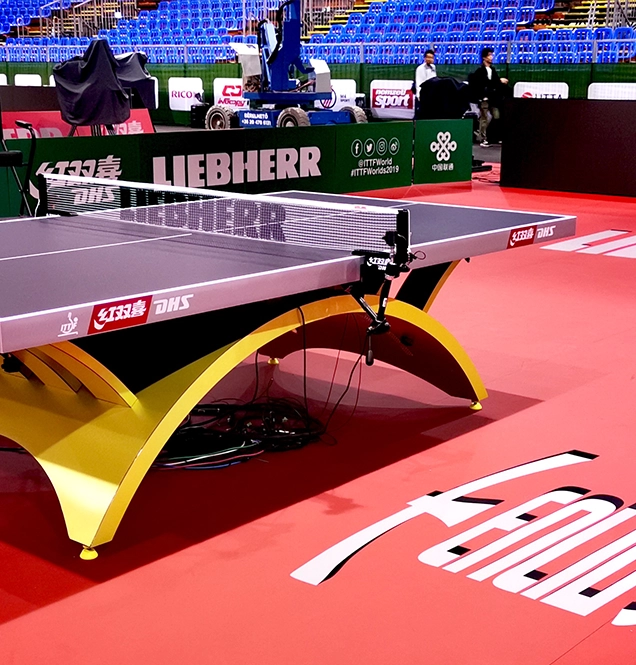Nov . 06, 2024 16:50 Back to list
Choosing the Best Flooring Options for Table Tennis Courts
Understanding Table Tennis Court Flooring Key Considerations for Optimal Performance
Table tennis, a sport born out of leisure and quickly developed into a competitive arena, demands precision, speed, and agility. A critical yet often overlooked aspect of the game is the flooring on which it is played. The type of court flooring can significantly affect players' performance, health, and the overall quality of the game. In this article, we will explore the different materials and factors involved in selecting the best flooring for a table tennis court.
Importance of Table Tennis Court Flooring
The floor of a table tennis court provides not only a surface for play but also influences several key factors player movement, ball bounce, and injury prevention. Since table tennis is a fast-paced game that requires quick footwork and rapid transitions, the flooring must support these dynamics. The right floor can enhance player performance, whereas inadequate flooring may lead to injuries or hinder one’s ability to play effectively.
Types of Flooring Materials
1. Wood Commonly used in indoor sports facilities, wooden flooring is favored for its durability and excellent shock absorption properties. Maple and beech are popular choices due to their hardness and ability to provide consistent ball bounce. Professional tournaments often utilize high-quality wooden surfaces, with specific regulations concerning thickness, treatment, and finish to optimize game conditions.
2. Vinyl Another popular option, especially for multipurpose facilities, is vinyl flooring. It is available in a variety of colors and designs and offers good resilience and shock absorption. Vinyl is easier to maintain than wood and can be used in both recreational and competitive settings. However, it may not provide the same level of performance as traditional wooden courts when it comes to ball bounce.
3. Rubber Rubber flooring is known for its anti-slip properties and excellent cushioning, making it a popular choice for recreational facilities. It provides a textured surface that helps players maintain balance. However, rubber may not be ideal for high-level competitions where precise bounce dynamics are critical.
4. Synthetic Materials Innovative advancements have introduced synthetic sports flooring, which can mimic the properties of hardwood while offering enhanced durability and moisture resistance. These surfaces can be engineered to provide uniform bounce and reduced wear over time, making them an excellent alternative for both competitive and recreational use.
table tennis court flooring

Factors to Consider in Court Design
1. Surface Texture The texture of the flooring plays a pivotal role in how the ball interacts with the surface. A finely finished surface will allow for consistent bounce and speed, which is essential for maintaining the standard of play.
2. Shock Absorption Proper shock absorption reduces the strain on players' joints and helps prevent injuries. This is particularly important for a sport that involves quick lateral movements and rapid acceleration.
3. Maintenance Different flooring materials require varying levels of upkeep. Wood needs periodic refinishing, while vinyl and synthetic floors may only need regular cleaning. Selecting a flooring material with a maintenance regime that fits the facility’s use patterns is key to ensuring longevity and performance.
4. Indoor vs. Outdoor While most competitive table tennis is played indoors, considering the environment is essential. Indoor flooring must withstand extreme humidity levels, whereas outdoor surfaces require UV resistance and weather durability.
Conclusion
Choosing the right flooring for a table tennis court is crucial for both players and facility operators. Wood remains the gold standard for professional competition due to its excellent performance characteristics. However, vinyl and synthetic options present viable alternatives for varying needs, especially in multifunctional spaces.
Effective flooring not only enhances the gameplay experience but also prioritizes player safety and comfort. Organizations must evaluate their specific needs, such as level of play, maintenance capabilities, and budget, when selecting the appropriate surface. As the sport continues to grow in popularity, investing in quality flooring can make a significant difference in the overall experience for players and spectators alike. In essence, the right court flooring can elevate game performance and contribute to the continued success of table tennis as a competitive sport.
-
Wood Sports Flooring Enhanced by GPT-4-Turbo | Top Performance
NewsAug.02,2025
-
Sport Court Tiles with AI Innovation | Durable & Safe
NewsAug.01,2025
-
Vinyl Carpet Flooring | Durable & Waterproof Design
NewsJul.31,2025
-
Premium Basketball Board Stand with GPT-4-Turbo AI
NewsJul.31,2025
-
Premium Maple Flooring for Gyms & Homes | PVC & Vinyl Options
NewsJul.30,2025
-
Premium Outdoor Basketball Court Tiles for All Weather Use
NewsJul.30,2025

